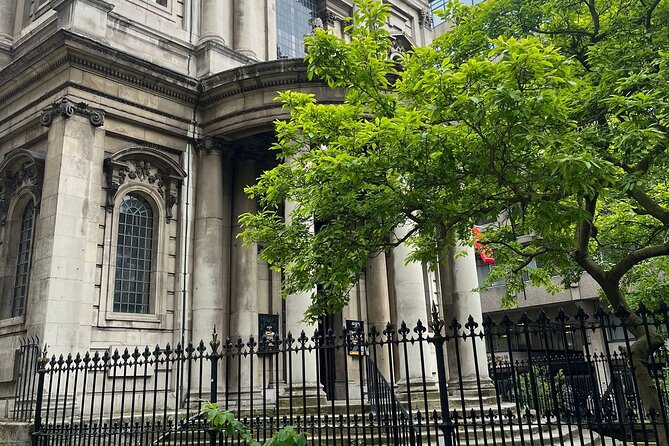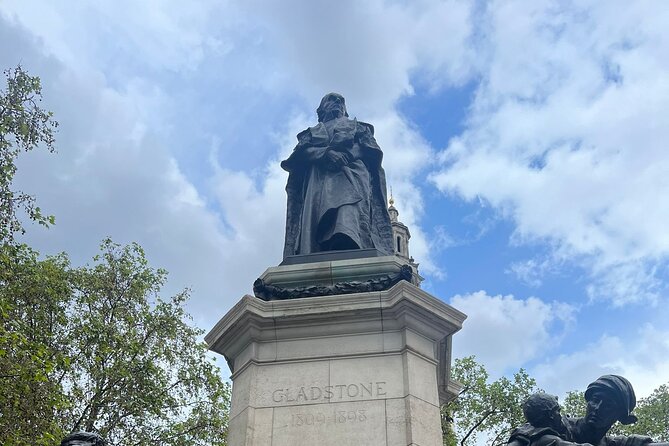Dickens & Woolf: Ways of Seeing
Ever wondered how two literary giants like Dickens and Woolf viewed the world around them?
Their unique perspectives offer a fascinating glimpse into the societal norms and human behavior of their times.
By examining their works through the lens of ‘Ways of Seeing,’ readers can uncover hidden depths and uncover connections that may have previously gone unnoticed.
So, what secrets do the writings of Dickens and Woolf hold about the human experience and the art of storytelling?
Key Points

- Dickens and Woolf challenge perceptions of reality and illusion.
- Their narrative styles blend personal experiences with societal landscapes.
- Visual imagery and symbolism enrich storytelling depth and evoke emotions.
- Both authors inspire generations to explore boundaries of imagination and expression.
Here's some more nearby activities we've reviewed
Exploring the Literary Legacy

Exploring the literary legacy of Dickens and Woolf offers a captivating journey through the rich tapestry of British literary history. It weaves together the distinct voices and visions of two literary giants. Their works are interconnected through various literary connections and historical contexts, showcasing a deep understanding of the societal issues prevalent during their times.
Dickens, with his vivid characters and social commentary, provides a lens into the Victorian era. Meanwhile, Woolf’s stream-of-consciousness narrative and innovative writing techniques revolutionized the way readers engage with literature. Their creative interpretations of human experiences and emotions resonate with audiences, transcending time and space to remain relevant in today’s world.
Dickens and Woolf’s lasting impact on literature lies not only in their storytelling but also in their ability to inspire generations of writers to push the boundaries of imagination and expression.
Dickens and Woolf’s Influences

Dickens and Woolf drew inspiration from diverse sources, shaping their literary masterpieces with profound influences from their personal experiences and the societal landscapes of their respective eras.
Dickens was deeply influenced by the works of William Shakespeare and the picaresque tradition, which is evident in his vivid characters and intricate plot developments.
On the other hand, Woolf was influenced by the stream of consciousness narrative style of authors like James Joyce, which she expertly employed in her modernist novels to explore the complexities of human thought and emotion.
These literary influences greatly impacted their narrative styles, allowing them to create works that continue to captivate readers with their depth and innovation.
Visual Imagery in Their Works
Incorporating vibrant visual imagery, Dickens and Woolf skillfully painted vivid pictures in their works, evoking powerful emotions and immersing readers in rich, detailed settings.
Dickens, known for his descriptive prose, used symbolic imagery to enhance his narratives. From the foggy streets of London in ‘Bleak House’ to the contrasting worlds of wealth and poverty in ‘Great Expectations,’ his artistic vision brought the characters and settings to life.
Similarly, Woolf’s writing was marked by her ability to create intricate visual landscapes that reflected the inner thoughts and emotions of her characters. In works like ‘To the Lighthouse,’ she employed vivid descriptions to capture the essence of fleeting moments and complex relationships, showcasing her unique artistic vision.
Themes of Perception and Reality
With their masterful use of visual imagery, Dickens and Woolf laid a foundation that seamlessly transitions into exploring the intricate themes of perception and reality within their works.
The authors explore the complex interplay between reality vs illusion, delving into perception studies to challenge readers’ understanding of truth perception and reality interpretation.
Dickens often portrays characters who grapple with societal facades and hidden truths, inviting readers to question what’s real and what’s merely a facade. Similarly, Woolf’s narratives blur the lines between perception and reality, prompting readers to contemplate the subjective nature of truth.
Through these themes, both authors invite readers to engage critically with the characters’ experiences, encouraging a deeper exploration of the complexities of human perception and the construction of reality.
Symbolism and Interpretation
Exploring layers of symbolism and interpretation adds depth and richness to the narratives crafted by Dickens and Woolf, inviting readers to delve beyond the surface of their stories. Symbolism in literature involves using symbols to represent ideas or qualities, adding a deeper meaning to the text. Interpretation, on the other hand, requires readers to analyze and decipher these symbols to uncover the underlying messages or themes the authors intended to convey. Let’s take a closer look at how Dickens and Woolf masterfully weave symbolism into their works:
| Symbolism | Dickens | Woolf |
|---|---|---|
| Nature | Represents rebirth and renewal in "Great Expectations" | Symbolizes freedom and transformation in "To the Lighthouse" |
| Weather | Reflects characters’ emotions in "Bleak House" | Mirrors mood and atmosphere in "Mrs. Dalloway" |
| Journey | Symbolizes personal growth in "David Copperfield" | Represents self-discovery in "Orlando" |
Narrative Techniques Comparison
Dickens and Woolf employ distinct narrative techniques to captivate readers and enhance their storytelling prowess. Both authors showcase unique writing styles and narrative perspectives in their works.
Dickens is known for his intricate plots and vivid character descriptions, often using symbolic motifs to convey deeper meanings. On the other hand, Woolf is celebrated for her stream-of-consciousness technique, providing readers with intimate insights into her characters’ thoughts and emotions.
While Dickens employs a more traditional storytelling approach with intricate plots and detailed settings, Woolf experiments with narrative structures, offering a more introspective and experimental reading experience.
Character Development Insights
In their respective works, Dickens and Woolf skillfully sculpt their characters’ journeys, offering readers profound insights into the complexities of human nature. Both authors delve deep into the psychological depth of their characters, employing various storytelling techniques to reveal inner struggles and motivations.
Dickens, known for his rich symbolism, uses characters like Scrooge in ‘A Christmas Carol’ to explore themes of redemption and empathy. On the other hand, Woolf intricately weaves character dynamics in works like ‘Mrs. Dalloway’, showcasing how individual perceptions and societal expectations shape identities.
Through their meticulous attention to character development, both Dickens and Woolf create narratives that resonate with readers on a profound level, inviting them to reflect on the intricacies of human behavior and emotion.
Impact on Modern Literature

Both Dickens and Woolf’s profound exploration of character depths and human complexities have left an indelible mark on modern literature, influencing generations of writers and readers alike. Their works continue to resonate through modern interpretations and literary connections, shaping the way contemporary authors approach storytelling and character development.
Dickens’ vivid portrayals of social issues and intricate character relationships paved the way for a deeper understanding of human nature in literature. Woolf’s innovative narrative techniques and introspective explorations of consciousness have inspired countless modern writers to experiment with form and explore the complexities of the human psyche.
The impact of Dickens and Woolf on modern literature is undeniable, with their legacy enriching the literary landscape with timeless themes and profound insights.
Here's a few more nearby tours and experiences we have reviewed.
- London Eye River Cruise and Standard London Eye Ticket
- London by Night Sightseeing Tour – Open Top Bus
- The Beatles London Walk
- Private Sherlock Holmes Walking Tour in London
- Inner Circle Access of Stonehenge Including Bath and Lacock Day Tour From London
- White Cliffs of Dover and Canterbury Cathedral Tour From London
Common questions
Are There Any Specific Dress Code Requirements for the Tour?
Tour participants are advised to dress comfortably and appropriately for the tour. There is no strict dress code, but it’s recommended to wear sensible shoes and clothing suitable for walking and exploring.
Is There a Recommended Age Range for Participants on This Tour?
While there isn’t a strict recommended age range for the tour, participants should dress comfortably for the experience. Viator ensures a diverse group of travelers, making this exploration suitable for all ages.
Will There Be Any Breaks or Rest Stops During the Walking Tour?
During the walking tour, participants can expect rest breaks and comfort stops at strategic points along the route. These breaks provide opportunities to relax, refresh, and fully enjoy the experience without feeling rushed or fatigued.
Are There Any Recommended Reading Materials to Prepare for the Tour?
Sure thing! When preparing for the tour, travelers can enhance their experience with literary analysis by diving into recommended reading materials that offer insights into the historical context of the locations featured on the walk.
Can Participants Take Photographs During the Tour?
Participants can take photographs during the tour, but it’s vital to respect photography etiquette and be mindful of group dynamics, privacy concerns, and cultural sensitivity. Remember, capturing memories should enhance the experience for everyone involved.
Here's more of our most recent tour reviews happening neaby
- Private Transfer: London Hearthrow Airport to St Albans.
- The Authentic British Food Tour
- London: See 40+ London Sights – Fun Local Guide
- Private Professional Photoshoot at Westminster Abbey in London
- The Sightseeing Flex Pass London
- Giza: Full Day Tour Giza Pyramids and Memphis and Saqqara
- Tower of London Kid-Friendly Private Tour
- London: Landmarks and Gems Bike Tour
- Heathrow Airport: 1-Way Meet & Greet Transfer to London
- Luton Airport To/From Stansted Airport – Private Transfer
- London: Madame Tussauds, SEA LIFE and London Dungeon Entry
Last Words
To sum it up, ‘Dickens & Woolf: Ways of Seeing’ offers a mesmerizing glimpse into the worlds of two literary giants. By delving into their influences, imagery, and narrative techniques, participants are treated to a rich exploration of perception and reality.
As Charles Dickens and Virginia Woolf’s works continue to inspire modern literature, this tour provides a unique opportunity to appreciate their enduring impact. Join us on this unforgettable journey through the streets of London and see literature come to life!